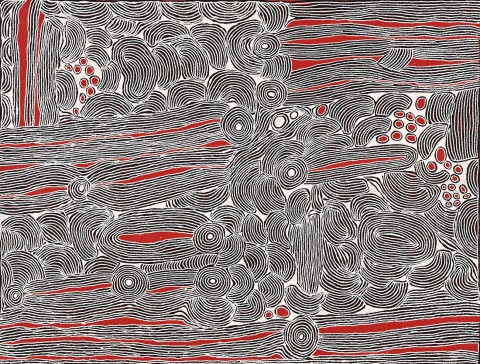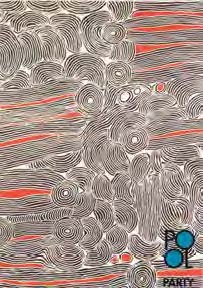WOMEN AT NGAMINYA, 2005
NINGURA NAPURRULA
synthetic polymer paint on linen
210.0 x 280.0 cm
bears inscription verso: artist's name, size and Papunya Tula Artists cat. NN0504019
Papunya Tula Artists, Alice Springs, Northern Territory
Pool Party Art Auction, Art Gallery of New South Wales, Sydney, 3 November 2005, lot 42
Private collection, Sydney
Wonderful World: celebrating the University of South Australia’s new Anne And Gordon Samstag Museum of Art, Anne And Gordon Samstag Museum of Art, University of South Australia, Adelaide, 12 October – 7 December 2007
Pool Party Art Auction catalogue, Art Gallery of New South Wales, Sydney, 3 November 2005, cat. 42 (illus. and front cover)
Green, E., and Hansen, D., et al., Wonderful World: celebrating the University of South Australia’s new Anne And Gordon Samstag Museum of Art, Anne And Gordon Samstag Museum of Art, Adelaide, 2007, p. 41 (illus.)
Ningura Napurrula was one of the undisputed leaders of the group of Pintupi women artists who emerged on the public art scene through the Papunya Tula Artists cooperative in the second half of the 1990s. The widow of one of the founding members of the Papunya painting group in the early 1970s, Yala Yala Gibbs Tjungurrayi (c.1928 – 1998), Napurrula was instrumental in the collaborative Kintore Women’s Painting1 made for the Western Desert Dialysis Appeal in 1999 that announced the arrival of a new direction in desert painting. Included in the project, was another large canvas completed by Kintore men and both these works belong to a continuing tradition of collaborative art making as practiced in ritual circumstances, now extended to creating art to raise funds for specific community needs.
Painted in April 2005, Women at Ngaminya was held over by Papunya Tula Artists to be placed in another communal project, this time to raise funds through the Charles Perkins Children’s Trust to build swimming pools in the communities of Maningrida in Arnhem Land and Kintore (Walungurru) in the lands of the Pintupi in the Gibson Desert. The so-called Pool Party auction was held on the fortieth anniversary of the famous 1965 Freedom Rides lead by Charles Perkins to challenge segregation in rural AustraliaN towns and included the famous protest at the public swimming pool in Moree, New South Wales.
Women at Ngaminya was painted when Napurrula was at the peak of her powers, a decade before she passed. It is one of a small number of major large canvases made around that time. These include Untitled (Wirrulnga), 2000, in the collection of the Art Gallery of New South Wales, Sydney,2 Women at Wirrulnga, 2004, and two untitled paintings from 2004 and 2006, the latter three in the collection of the National Gallery of Australia, Canberra.3
Women at Ngaminya features Napurrula’s distinct method of layered, undulating paint application that is based on the technique desert women use to depict narratives in palimpsests of drawing in sand. The imagery celebrates a fecund, landscape redolent with ancestral women’s powers that are tapped by successive generations of Pintupi women. Wirrulnga is associated with birth and the lines emanating from the roundels in the painting allude to pregnant women generally, and specifically to an ancestral woman of the Napaltjarri sub-section.
1. Perkins, H., Tradition Today: Indigenous Art in Australia, Art Gallery of New South Wales, Sydney, 2004, p. 159 (illus.)
2. Perkins, H., pp. 108 – 9 (illus.)
3. For Untitled, 2006, see Cubillo, F. and W. Caruana (eds), Aboriginal & Torres Strait Islander Art: Collection highlights, National Gallery of Australia, Canberra, 2010, p. 63 (illus.)
WALLY CARUANA

